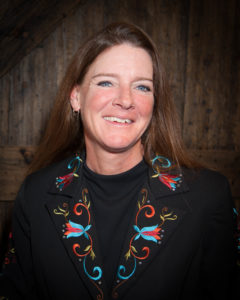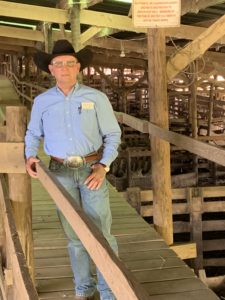In the midst of the pandemic and economic uncertainty, livestock auction markets nationwide protected competition and price discovery.
By Eric Grant
The night everything changed began in an unexpected way — a basketball game between the Utah Jazz and Oklahoma City Thunder.
It was March 11, and many folks sitting in the comfort of their living rooms thought the decision to cancel the game — and that same evening, the entire season — was the NBA acting too cautiously. A Jazz player tested positive for COVID-19, and a panic began that night which would soon affect every American.
Just a short distance from the basketball coliseum — and what normally would seem a million miles from the drama of professional sports — lies the sprawling network of pens and alleys that comprise the Oklahoma National Stockyards Co.
Kelli Payne is the sixth general manager of the facility and the first woman to hold the position in its history. She got word of the game’s cancellation the next morning around 7 a.m., and admittedly didn’t think too much of it.
“No big deal, right?” she recalls.

Except that fear of the virus spread more quickly than the virus itself, and suddenly everything she managed was called into question — the cattle sales, the tours, the trade shows and the events in the historic Stockyards City.
“Stop the ride and let get me off,” Payne remembers.
The OKC stockyards, which markets about 400,000 head of feeder and stocker cattle a year, has survived its share of challenges over the years. Since its founding in 1910, more than 100 million head of livestock have passed through its gates. The market has helped ranchers sell their cattle through the uncertainty of two world wars, the Cold War, the Great Depression and even the Spanish Flu pandemic of 1918-1919.
But there was no blueprint on that day in early March.
Working with organizations like the Livestock Marketing Association, which represents the interests of livestock markets across the country, and Texas and Southwestern Cattle Raisers Association, Payne and her team decided to focus on the things they could control. They set into motion a series of actions to protect both buyers and sellers from the disease, while keeping the markets open at all costs.
They limited the number of people in the sales facility. They practiced social distancing among their workers, changing work shifts of maintenance crews, for instance, so fewer people would be working together at the same time.
And, they focused on the well-being of their people.
“We’d ask, ‘Are you OK? How are you handling this?’” Payne says. “There’s a softer side of this, and we knew we needed to take care of our people.”
But the markets — similar to the worldwide economy — were stumbling, and there was no clear-cut direction on where or when to sell cattle.
“It was the craziest volatility I’ve ever seen in my life,” she says. “The market was changing so quickly that you couldn’t explain it. Everybody in the system had their own set of problems — and everybody was trying to get clarity.”
Gaining clarity
Russ DeCordova, Buffalo, has spent a lifetime in the livestock marketing business — and like Payne, he’d never seen anything like this.
DeCordova, who owns and operates Buffalo Livestock Marketing, has also been a representative for Superior Livestock Auction since its beginning.
“In February, I had checked my accounts and we were 10% ahead for the year for marketing, but by the time all this broke, within 30 days we were that much behind,” he recalls. “Everybody got scared and didn’t know what to do.”
Luckily, this spring was a good year for grass, so he encouraged many of his sellers to keep their calves on pasture — just long enough to let the market stabilize.
The flexibility to hold cattle longer — and to turn them out as grass got its bloom — is one of the key economic advantages to raising beef, and one of the stories he told his customers.
“We just took the attitude that we were going to be as tough as we could to help our customers get through this,” DeCordova says. “But people still have to sell cattle, and we knew we had to do everything we could to help.”
The first thing he did was restrict access to his livestock market while keeping business moving.
“We asked non-sellers not to come,” he says. “And if our buyers got their orders filled, we asked them to settle up and go home. We mailed checks to our sellers. We wanted as few people as possible to come in, but people still have to pay their bills. That’s where we come in — and why it’s so important that we stayed open.”

An essential enterprise
Sitting at his son’s baseball game is where Greg Goudeau, Navasota, first started contemplating the far-reaching consequences of the pandemic.
“The Houston Livestock Show and Rodeo had just gotten canceled. There were predictions that 2.4 million people were going to die from this virus,” he remembers. “I thought, ‘This is going to be bad. How are we going to stay open when all the other businesses are being forced to close?’”
Goudeau owns and operates Navasota Livestock Auction. He faced a unique challenge when the U.S. economy began to collapse, and job layoffs began.
“There’s not a single producer who sells through our auction that makes his living off of cattle,” he says. “They’ve all got jobs in town. Some guys needed to sell cattle because of layoffs. There’s a lot of oil field workers in this area. They’re losing their jobs, and they sold their cattle because they had to have the money.”
Goudeau immediately contacted a county judge to plead his case. “I said, ‘I understand the difference between non-essential and essential. I have a restaurant, so I understand what non-essential is, but you’ve got to call auction markets essential because these farmers and ranchers have to make a living, and we’ve got to keep food moving through the system.’”
All across America, livestock markets were making the same case: Not only were they essential to ensuring true price discovery, but also to the financial well-being of rural Americans. More than half the cattle raised in the United States are marketed through livestock markets, so their economic contribution is significant.
While long-term impacts of COVID-19 remain to be seen, Goudeau, DeCordova and Payne suggest livestock markets will continue to play a critical role in serving their local communities — and fighting to protect pricing mechanisms that serve all sectors of the cattle industry.
By late March, a call for relief echoed across the supply chain and into Washington.
Texas and Southwestern Cattle Raisers Association leaders submitted a letter to Agriculture Secretary Sonny Perdue, encouraging the U.S. Department of Agriculture to address the dramatic losses cattle producers were experiencing due to the discrepancy between beef cutout and live cattle prices, all as beef demand skyrocketed.
In April, a number of industry organizations, including the National Cattlemen’s Beef Association and the Livestock Marketing Association, supported investigations by the USDA and the Department of Justice into pricing differentials between the wholesale price packers receive for beef and the prices they pay for live cattle.
“We have to have competition,” DeCordova says. “It’s what drives our business. It makes us a better industry.”
DeCordova and others are particularly concerned, saying producers should not move away from producing higher-quality cattle for the marketplace — especially as the industry and the general economy begin to move out of the pandemic’s dark days.
“This is going to be a huge eye-opener for everybody in this business, and it will trickle back down to the ranch,” Goudeau says. “If the guy who bought your cattle last year is losing money because of COVID-19, he’s not going to be in the mood to pay top dollar for your cattle down the road. We need to be focused on marketing good calves not just selling them.”
That’s why Goudeau has implemented weaned calf sales as a way of adding value to customers’ calves.
DeCordova also suggests producers can expect more opportunities to market preconditioned and weaned calves through livestock auction markets. “We want to help advertise the fact that these cattle have been weaned, with two rounds of shots, and have had good nutrition,” he says. “This’ll help everybody in the system.”
“Don’t quit doing better,” Payne adds. “There were two things that flew off the grocery shelves last spring: toilet paper and beef. People love and need our product. We’ve got to keep moving forward.”
Connection and competition
Ironically, perhaps the greatest outcome has been how livestock markets have capitalized on their multi-year commitments to new technologies, such as video streaming and social media, to expand their reach, increase relevance and ensure true price discovery — even in the midst of the worst economic downturn in memory.
At Oklahoma National Stockyards, the livestock market built on its nearly two decades of streaming sales by conducting “real-time” Facebook “lives,” answering questions about the markets from sellers, many of whom couldn’t physically attend the sales because of social distancing restrictions.
“What other doors does this open?” Payne asks. “There’s no playbook buried in the dust somewhere. But we do know that people are at home. They’re more sedentary, and we’re getting more viewership and engagement of our sales than ever before. Folks are watching us from around the world — Australia, Ireland, Mexico — you name it. They’re curious. They want to know what we’re doing. And this is a huge opportunity for us to tell our story.”
Payne also points to another technological advancement made more relevant by social distancing — a text group supported by TSCRA special rangers to track down stolen cattle.
“If there’s a theft, it’s sent out on a group text,” Payne describes. “We had one of them a week or two ago. The group text had photos of the cattle. It went out and, within an hour, they’d located the cattle in the Texas Panhandle. All of this stuff is a game changer and will impact our business for years to come.”
In the end, livestock markets played a critical role in helping the industry find its footing in one of the most uncertain times in history. Not only did they provide essential services, such as providing the ability for producers to convert their cattle into cash, but also underpinned the industry’s price discovery effort.
“True price discovery is something that you only get with a live auction,” Payne concludes. “It’s imperative we keep that going.”
This story originally ran in the July issue of The Cattleman magazine, a Texas and Southwestern Cattle Raisers Association member benefit.
